新人教选修六-Unit-4-Global-warming单元教学设计
人教版选修六Unit4《Globalwarming》word教案1

Teaching Plan for Unit 4 Global Warming (1st period)设计思路:教材分析:本课文取自于人教版新教材选修6 Unit 4,文章篇幅较长,题材属于科普类文章。
科普类文章内容较为枯燥,术语、生僻词较多,学生读起来较有困难。
好在文章话题——全球变暖的问题已为公众熟知,学生对此话题并不陌生,这一点有利于教学。
学情分析:学生是外国语学校学生,语言基础和能力水平较高,这对教学活动的展开很有帮助;但是授课者从未接触过这些学生,对他们的实际情况几乎一无所知,且上海和江西同级别的重点学校的学生水平并不一致,这给授课者在预估学生能力方面产生较大的障碍,给备课带来极大的困难。
另外,本节课因特殊原因只有35分钟,这是本堂课最难解决的问题。
授课者不得不考虑既要将文本作适当的阅读处理又要有适当的拓展,以及保证课堂的完整性的问题。
上课框架:本堂课是这篇课文的第一课时,以学生掌握文章的主旨和具体内容为主要目标。
文章标题“The earth is getting warmer but does it matter?”非常清楚地告诉了我们文章将阐述地球在不断变暖的事实,并提出疑问这究竟有没有关系?因此,本课大体分两部分进行:第一部分处理地球正在变暖的原因和事实依据,第二部分则带领学生阅读“这是否有关系”,并引发自己的思考。
因此,我设计了6个任务来完成本堂课的阅读教学。
其中五个任务以文本为基础,通过带读、自读、互相读的方式,学生利用predicting、scanning、skipping等阅读技巧来完成文本阅读,了解主旨,熟悉文章内容,抓取相关信息。
最后一个活动为讨论,使学生明白全球变暖问题日趋严重,我们还是要有应对措施,并加强环保意识。
Teaching materials:Textbook---Student’s Book 6, New Senior English for China, People’s Education Press Teaching Aids: a blackboard, a multimedia kitObjectives:I.Of Knowledge:Students will know basic scientific facts concerning global warming, scientist s’differentattitudes towards it and the writer’s opinion as well.II.Of AbilityA.Students will continue to develop their predicting skill to guess the main idea of the articleand get prepared for the reading.B.Students will practice the scanning skill to get the specific information.C.Students will learn to think critically about the problems the writer has raised.III.Of EmotionA.Students will learn we should conserve energy and protect the earth.B.Students will want to get involved in the classroom activities when doing the tasks.Procedures:I.Before ReadingLead-inA graph which shows the changes of the average temperatures of Jiangxi Province from 1959 to 2006. What can you tell from the graph? (Students’ answer may vary.)This leads to our topic today---Global warming.1. Predicting:1)What can you infer from the title?2)What are the two graphs about?II. While Reading(To make sure we are always on the same page, please mark each paragraph by writing Para. 1, Para. 2…in front of each paragraph. How many paragraphs do we have?)2. Scanning1)Look for people’s names. Circle them with a red pen.①Who wrote the magazine article?②What are the names of the three scientists mentioned in the article?2)Para. 1 & 2①What has caused global warming? (vocabulary teaching involved)②Which sentence tells us what the writer will talk about in the article?3.Reading: Para. 3, 4&5How has this come about?Further questions:1)Can you give the three examples of the fossil fuels?2)Who gave us scientific evidence that the amount of carbon dioxide has been increasing?3)Some gases can trap heat from the sun. What do scientists call this phenomenon?What would happen if there were no greenhouse effect? What would happen if there were too many greenhouse gases?4)How high will the temperature increase go according to Janice Foster?4.Reading: Does it matter? Pair Work (Para. 6)The students sitting on my left hand side will read about Janice Foster while the others will read about George Hambley. Then fill in the blanks in the table concerning your reading part. Exchange information with your desk mate so that he/she can fill in the other half.5. Reading: Para. 71)The writer probably thinks ________.A. It matters.B. It doesn’t matter.2) What probably does the writer want us to do by the last two questions? III. Post Reading6. Group Discussion: What can/should we do?•At home/work/school•Clothing /food/ housing/ transportation •Policies, laws, finance•Media, transportation, design ofbuildings•You may also refer to the pictures on Page 25.Make a list:(Summary: Wrap up the topic)IV. Homework:1.Read the text again and finish Comprehending 1&2 on Page 27.2.Choose sides and prepare for a mini debate on whether we should something about globalwarming. You may refer to the following websites.①/pub_display.php?pub_id=2872②/xiawf001/default.html?page=5③/global-warming-positives-negatives.htm3. Underline important words and phrases.。
选修六-Unit-4-Global-Warming-教案设计

选修六 Unit 4 Global Warming 教案Warming up1. Global warmingWhat caused it? ( lead...to..)The harmful effects of global warmingWhat should we do to deal with the problem?2. Brainstorming: We depend on energy to many things in our daily lives. We consume energy every day. Consumer--Energy lights our cities, heat our room, transportation, equipment, ...3. 必备句子1 An energy source is renewable when supplies of it never run out and non-renewable when one day they will run out.Renewable sources-- windmills, solar ,hyydro-electricnon-renewable sources --coal power station, oil refinery,nuclear power plant run out, run out of, use up4. A greenhouse is made of ______and is used for ______________, especially during _____weather.Be made of, be made from, be made up of, be made intoBe used for doing sth, be used to do sth, be used to doing sthReadingStep 1. Pre-readingIn the atmosphere surrounding the earth there are gases called greenhouse gases.(画画)4. Greenhouse EffectGlobal warmingGr eenhouse gases tr appe d the heat fr o m the sun,whic h causes the tempe r atur e of ea r th goes up.Step 2 . SkimmingSkim the title:THE EARTH IS BECOMING WARMER – BUT DOES IT MATTER?1) What is the main topic?A. The earth.B. Global warmingC. Becoming warmer doesn’t matter.2) Where does this article most probably come from?A. NewspaperB. NovelC. Magazine3) Who wrote the article?4) What is the name of the magazine?Tip: In English, some nouns begin with a capital letter(大写字母), such as names of people and places, title s of magazines, newspapers, stories and books, people’s titles(头衔), etc..必背句子2—Earth Care’s Sophie Armstrong explores these questions.Step 3 Careful reading1) What causes global warming?(para 1)= How has this come about?come about表示“发生、产生”,多指事情已经发生了,但还不知道为什么,常用于疑问句和否定句,例如:happen常指具体事件的发生,特别指那些偶然的或未能预见的“发生”。
Unit 4 Global Warming 教学设计1-公开课-优质课(人教选修6精品)
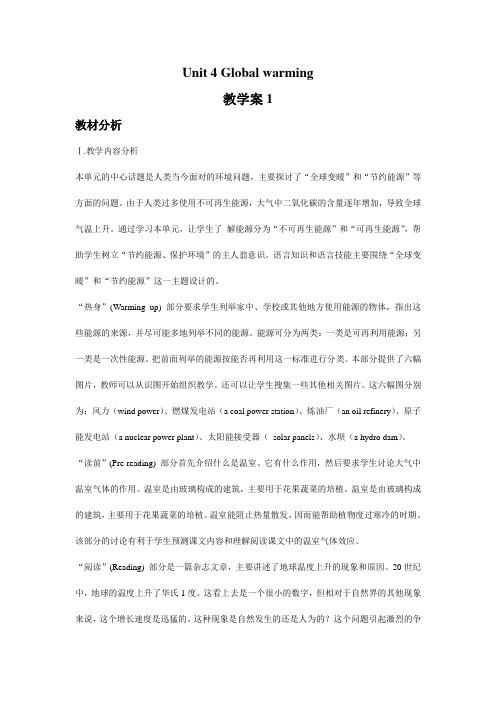
Unit 4 Global warming教学案1教材分析Ⅰ.教学内容分析本单元的中心话题是人类当今面对的环境问题,主要探讨了“全球变暖”和“节约能源”等方面的问题。
由于人类过多使用不可再生能源,大气中二氧化碳的含量逐年增加,导致全球气温上升。
通过学习本单元,让学生了解能源分为“不可再生能源”和“可再生能源”,帮助学生树立“节约能源、保护环境”的主人翁意识。
语言知识和语言技能主要围绕“全球变暖”和“节约能源”这一主题设计的。
“热身”(Warming up) 部分要求学生列举家中、学校或其他地方使用能源的物体,指出这些能源的来源,并尽可能多地列举不同的能源。
能源可分为两类:一类是可再利用能源;另一类是一次性能源。
把前面列举的能源按能否再利用这一标准进行分类。
本部分提供了六幅图片,教师可以从识图开始组织教学。
还可以让学生搜集一些其他相关图片。
这六幅图分别为:风力(wind power)、燃煤发电站(a coal power station)、炼油厂(an oil refinery)、原子能发电站(a nuclear power plant)、太阳能接受器(solar panels)、水坝(a hydro dam)。
“读前”(Pre-reading) 部分首先介绍什么是温室、它有什么作用,然后要求学生讨论大气中温室气体的作用。
温室是由玻璃构成的建筑,主要用于花果蔬菜的培植。
温室是由玻璃构成的建筑,主要用于花果蔬菜的培植。
温室能阻止热量散发,因而能帮助植物度过寒冷的时期。
该部分的讨论有利于学生预测课文内容和理解阅读课文中的温室气体效应。
“阅读”(Reading) 部分是一篇杂志文章,主要讲述了地球温度上升的现象和原因。
20世纪中,地球的温度上升了华氏1度。
这看上去是一个很小的数字,但相对于自然界的其他现象来说,这个增长速度是迅猛的。
这种现象是自然发生的还是人为的?这个问题引起激烈的争论。
许多科学家认为,这种变化是人类燃烧矿物燃料所致。
【教案】人教版选修六Unit4 Global Warming Reading
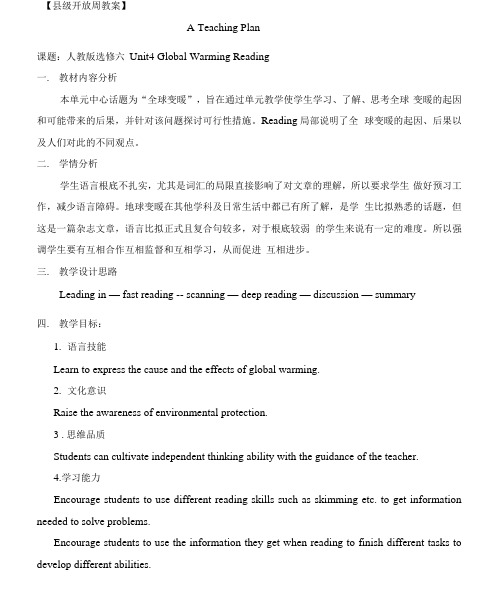
【县级开放周教案】A Teaching Plan课题:人教版选修六Unit4 Global Warming Reading一. 教材内容分析本单元中心话题为“全球变暖”,旨在通过单元教学使学生学习、了解、思考全球变暖的起因和可能带来的后果,并针对该问题探讨可行性措施。
Reading局部说明了全球变暖的起因、后果以及人们对此的不同观点。
二. 学情分析学生语言根底不扎实,尤其是词汇的局限直接影响了对文章的理解,所以要求学生做好预习工作,减少语言障碍。
地球变暖在其他学科及日常生活中都已有所了解,是学生比拟熟悉的话题,但这是一篇杂志文章,语言比拟正式且复合句较多,对于根底较弱的学生来说有一定的难度。
所以强调学生要有互相合作互相监督和互相学习,从而促进互相进步。
三. 教学设计思路Leading in — fast reading -- scanning — deep reading — discussion — summary四. 教学目标:1.语言技能Learn to express the cause and the effects of global warming.2.文化意识Raise the awareness of environmental protection.3 .思维品质Students can cultivate independent thinking ability with the guidance of the teacher.4.学习能力Encourage students to use different reading skills such as skimming etc. to get information needed to solve problems.Encourage students to use the information they get when reading to finish different tasks to develop different abilities.五. 教学重难点重点Help the students learn the cause and effects of global warming.难点How to guide the students to understand global warming better and collect specific details to voice their own views in a critical way.六. 教学方法Task-based Language Teaching Approach七. 教学策略充分利用多媒体辅助教学,发挥信息技术的作用,丰富教学内容,提高学生的学习兴趣和课堂教学效率。
新人教选修六-Unit-4-Global-warming单元教学设计
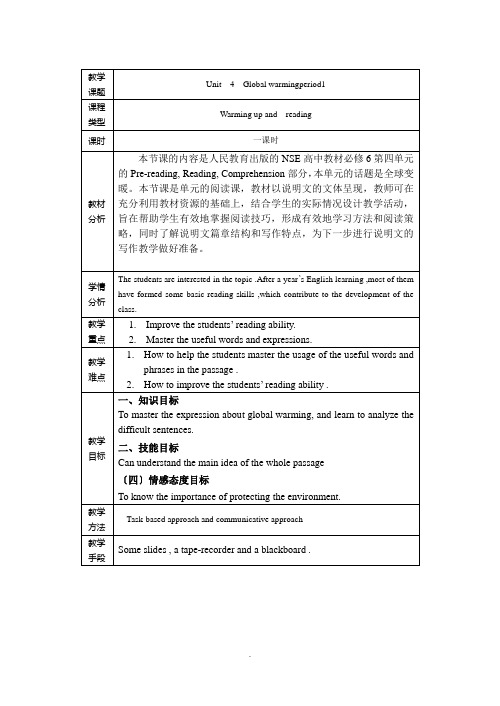
目标
〔一〕知识目标
Tograsp someuseful words and expressionsandlearn some useful sentence patterns
〔二〕能力目标
1.Get students to use someuseful words and expressions correctly .
Step 2 listening
Play the tape for students and pay attention to some important words and phrases
Listen to the tape and pay attention to some important words and phrases
2.Everyone believes that global warming is caused by the activity of humans.
3.Janice Foster believes that she can measure the future global rise in temperature.
Step 3languagepoints
Go through the passage and deal with anylanguage points
Learn the useful languagepoints
Step 4Practice
Ask students to do some practice
2. Develop students’sense of group cooperation
教学
方法
1.Task–based teaching and learning
人教版高中英语选修6《Unit4Globalwarming》教案
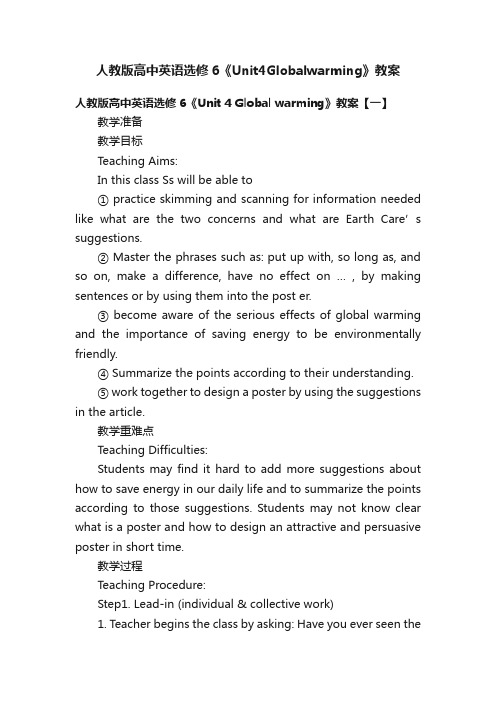
人教版高中英语选修6《Unit4Globalwarming》教案人教版高中英语选修6《Unit 4 Global warming》教案【一】教学准备教学目标Teaching Aims:In this class Ss will be able to① practice skimming and scanning for information needed like what are the two concerns and what are Earth Care’s suggestions.② Master the phrases such as: put up with, so long as, and so on, make a difference, have no effect on … , by making sentences or by using them into the post er.③ become aware of the s erious effects of global warming and the importance of saving energy to be environmentally friendly.④ Summarize the points according to their understanding.⑤ work together to design a poster by using the suggestions in the article.教学重难点Teaching Difficulties:Students may find it hard to add more suggestions about how to save energy in our daily life and to summarize the points according to those suggestions. Students may not know clear what is a poster and how to design an attractive and persuasive poster in short time.教学过程Teaching Procedure:Step1. Lead-in (individual & collective work)1. Teacher begins the class by asking: Have you ever seen themovie The Day After Tomorrow? and then let students enjoy a short movie clip with the following two questions:① What kinds of disasters have you seen in the film?② Can you guess how they came about (happen)?2. introduce the topic: global warming. And then have a further question:①What other disaster will be caused by global warming?【Designing Purpose】To arouse students’ interest by watching the movie clip and educe the topic, that is global warming. And then by showing a lot of pictures, make students know and understand the terrible effects of global warming, thus making preparations for promoting environmental protection.Step2. While Reading (Individual work)Skimming: Go through the first letter to f ind:① who is the writer?② what are his two concerns?Scanning: Read the second letter and answer the following questions:① Does Earth Care agree with Ouy ang Guang’s opinion that individuals can have no effect?② what are Earth Care’s suggestions?③ Can we carry those suggestions out? Why?【Designing Purpose】To help the students grasp the main information of the two letters by skimming and scanning. While stud ents get the answer to question1, ask them to find the supporting sentence : Together, individuals can make a difference. We do not have to put up with pollution. Guess the meanings of the two italicized phrases according to the surroundings and their understanding.Step3. Post reading (Pair work)1. Discussion: Make students discuss whether they can find more ways or suggestions about reducing carbon dioxide and saving energy in our daily life.Suggested ways:1) Use less hot water 7)Change a light bulb 8)Try car sharing2) Take a shower instead of a bath3) Buy fresh food instead of frozen4) Buy things that are actually in season5) Eat less high fat food like KFC and Macdonald6) Clean filters(过滤器) on your air conditioner.【Designing Purpose】To cultivate students to work in pairs and learn to summarize an opinion and share the knowledge of saving energy in daily life. To practice the ability of understanding the meaning of new words and expressions to remove the obstacles in reading.Step4. learn what is a poster (collective work)Know what is a poster by giving a simple sample and try to get the structure.【Designing Purpose】To know clearly a poster should have a heading, contents and an eye-catching slogan, which will make it easy for students to design an acceptable poster.Step5. Prepare the poster (individual & group work)1. Decide our content s:①Choose and decide five most important suggestions. (individual work)②Write them down on your paper and try to make them persuasive by using imperativesentences. (individual work)③Compare your list with your group members and decide five for your poster. (groupwork)2. Slogan and heading: showing sample posters to help them decide a heading and a slogan for your poster.【Designing Purpose】This is the most important part of this writing task. Students will be able to summarize and compose sentences by choosing and organizing what they want to say, thus improving their writing ability and the process of output based on what they have learned in reading part. And by learning some sample posters to help them decide their own heading and slogan.Step6. produce &show time (group work)With the heading, slogan and ways, students will not find it difficult to make a poster. What theyShould pay attention is how to illustrate their poster and make it more attractive. And then choose several pairs to represent their posters.【Designing Purpose】Making the poster will improve their cognitive capability of the importance of environmental protection and at the same time they can enjoy a sense of achievement in show time. And they make believe that individuals can really make a difference.课后习题Homework:Put their poster up around the school to make more students know about energy saving and global warming. Write a short passage to tell others how to solve the problem of global warming based on the suggestions you have collected and send it in your QQ zone or blog.板书板书设计:tsunami/ flood/More suggestions: make full use of paper/ use both sides of paperreuse waterlimit the time of using private carssend emails instead of cardsuse less hot wateralways take a shopping bag with youdrive a bicycle but not e-bicycle人教版高中英语选修6《Unit 4 Global warming》教案【二】教学准备教学目标Teaching goals 教学目标1. Target language 目标语言a. 重点词汇和短语energy, light (v.), heat (v.), renewable, non-renewable, fuel, blame, run outb. 交际用语Expressing agreement and disagreementYes, I agree with you.Yes, I think so.I believe that you’ve got it right.I don’t think so.I d on’t think that’s right.I’m afraid you are wrong.2. Ability goals 能力目标Enable the students to talk about different sources of energy and express their own ideas.3. Learning ability goals 学能目标Help the students learn how to give their ideas about the use of energy.教学重难点Teaching important points 教学重点Enable the students to express agreement and disagreement.Teaching difficult points 教学难点Enable the students to learn how to express agreement and disagreement.教学过程Step ⅠRevisionT: Good morning, everyone.Ss: Good morning, teacher.T: Sit down, please. Before class, I’ll check your homework first. Mary, would you read your homework to us?Check the students’ homework and have a discussion with the students about the mistakes Mary made. Let the students have a clear understanding about the mistakes and then correct them.Step ⅡWarming upT: As we all know, we depen d on energy to do many things in our daily life. Some people even say we could do nothing without energy. Can you tell me what we use energy for?Sa: Energy lights our cities.Sb: Energy heats our buildings.Sc: Energy entertains us. With the help of electricity, people have got a lot of fun from watching TV, playing computers and so on.Sd: There are many other electrical appliances that make our life more convenient and comfortable such as washing machines, microwaves, air conditioners and so on.Se: Today energy also helps people realize many so-called dreams in the past. For example, people can “fly” from one place to another by plane which runs on energy.Sf: It’s true. In fact, not only planes but also cars, ships and trains run on energy.T: Well done. All that you’ve just said is right. So it seems that energy plays a very important role in the modern world. Then where does all the energy come from? Open your books and turn to page 25. Look at the pictures on this page. They may help you find out the answers.After a while.T: Who’d like to tell us your answers?Sg: Wind power.Sh: Coal power.T: Right. Is there any difference between them?Si: Yes. Wind will never run out while coal is a limited source.T: It’s true. As we know, an energy source is renewable when supplies of it never run out while some supplies, such as coal, will definitely run out one day. Energy of this kind is called non-renewable sources. Please think of as many sources as you can and decide which energy sources on your list are renewable and which are non-renewable.If necessary, give some words related to the pictures which might be difficult for the students such as oil refinery, hydroelectric power and so on.The teacher should also collect as much information about different sources of energy as possible and show it to the students in class through a computer. In this way, the students will become more interested in this topic and their knowledge on this aspect will be enlarged.Sample answers:Step Ⅲ Listening and DiscussingT: Fromwhat we’ve just talked about, it is clear that energy does a lot of good to us.But every coin has two sides. Is there any negative effect of using energy?Sa: Yes.People use too much energy which is resulting in an increase in carbon dioxide.That is how the global warming comes about.Sb: Andmeanwhile it pollutes the environment.T: It’strue. Many people have realized the problem. N ext we’ll do some listeningpractice on this topic. Let’s see what other people think of this issue.Thestudents are asked to read the questions quickly to find out the listeningpoints first. Then listen to the tape twice and give the correct answers.T: No wplease turn to page 31. Let’s do listening. Before you listen to the tape,please read fast the statements in Exercise 1 to find out the listening points.Pay much attention to the key points while listening.Play thetape for the first time. Help the students get a general understanding aboutthe dialogue. The students listen and try to finish Exercise 1. Play the tapeagain, train the students’ ability to spot specific information and understandthe implication in the dialogue. The students listen and finish Exercise 2.Severalminutes later.T:Have you finished the exercises?Ss: Yes.T: OK,let’s check your answers.Explainsome difficult points if necessary.T: Nowread what Professor Chen and Li Bin say. Work in groups. Discuss who you agreewith and give reasons. Use some of the phrases listed in Exercise 2 or anyothers you know.课后习题Homework1. Review the new words and expressions you learned in this class.2. Preview Reading.。
高中英语选修6Unit+4+Global+warming+教案+
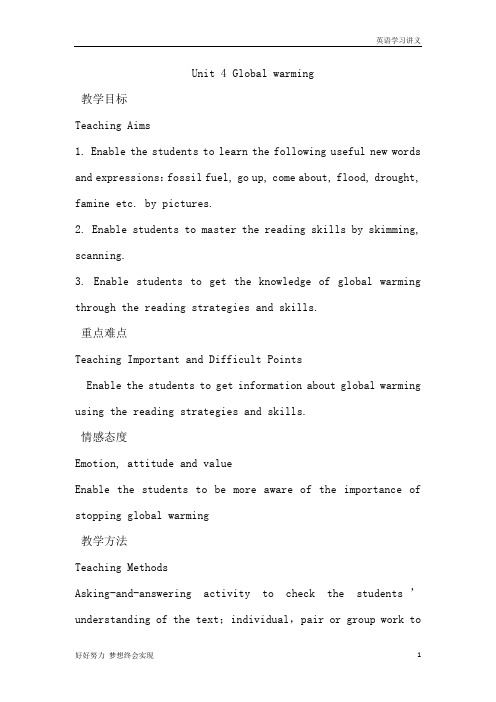
Unit 4 Global warming教学目标Teaching Aims1. Enable the students to learn the following useful new words and expressions:fossil fuel, go up, come about, flood, drought, famine etc. by pictures.2. Enable students to master the reading skills by skimming, scanning.3. Enable students to get the knowledge of global warming through the reading strategies and skills.重点难点Teaching Important and Difficult PointsEnable the students to get information about global warming using the reading strategies and skills.情感态度Emotion, attitude and valueEnable the students to be more aware of the importance of stopping global warming教学方法Teaching MethodsAsking-and-answering activity to check the students’understanding of the text;individual,pair or group work tofinish each task.5教学过程活动1 【教案】Globle warmingTeaching ProceduresStep 1. Lead-in1) Greetings and lead in.Show a film of The Day After Tomorrow and ask them the following question:What can you see in the film?--hurricane, tsunami, glacier melting .What other disasters do you know?--Flood, drought, famine.What causes the disasters?--It’s the global warming.What causes the the global warming?--Picture1: the burning of fossil fuelsPicture2: greenhouse gases: carbon dioxide, water vapor, methaneAs a result, the earth will become warmer and warmer.Step 2. Skimming:Glance the first paragraph:1. Who wrote the magazine article?A. Janice FosterB. Sophie Armstrong2. What is the topic of the article?A. The earthB. Global warming3. There are the names of the three scientistsin the article EXCEPT______.A. Dr Janice FosterB. Sophie ArmstrongC. Charles KeelingD. George HambleyStep 3. Scanning for detailed information (Group work)Part2(2-5)1. What do the two graphs show?--The first graph shows the temperature increase of one degree Fahrenheit between 1860 to 2000.--The second graph shows carbon dioxide went up from 1957 to 19972. What do you know about greenhouse effect?Greenhouse gases trap(吸收) the heat from the sun and therefore warm the earth.3. Which following is NOT TRUE about global warming? (D)A. The increase of temperature is due of the burning of the fossil fuels.B. The burning of the fossil fuels caused the increase in carbon dioxide.C. All believes that activities of humans have caused global warming.D. The attitudes of scientists toward it are the same.The different ideas of the effects of the global warming Part3(6)Step 4. SummaryWhat can we learn from the text? Fill in the bland.A. fossil fuelsB. human activityC.warmerD.differentE. heatEveryone believes that the earth is becoming ______. _______________ has caused this global warming: human produce energy by burning ___________. During this process, Dr. Foster HambleyMore carbon dioxide hasnegative effects:rise of the sea levelsevere storms, droughts,floods, famines,the spread of diseases,the disappearance of species.More carbon dioxide is a _positive_ thing, makes crops __produce__ more and will encourage __a great range of animals____.greenhouse gases are produced. Greenhouse gases can trap _____ from the sun and warm the earth which is called “greenhouse effect”.The attitudes of scientists towards global warming are ______. On the one hand, it is a positive thing. On the other hand, if there are too many greenhouse gases, more heat will be trapped, causing global warming.Step 5. After-reading group workWhat should we do to stop global warming?Discussion: Suggestions on global warming:turn off the electrical appliancetalk with family and friends about itrecycle things like bottles, plasticsplant more treesride bike rather than carwords 参考词汇: reduce, carbon dioxide, absorb, environment, plant, electrical appliances, recycleSentences structures 句型:We should ... in order to ...moIt is a good idea to ... because it can ...e.g. We should plant more trees in order to absorb the carbon dioxide .It is a good idea to plant more trees because it can absorb the carbon dioxide .Suggestions about global warmingNowadays, global warming is becoming warmer and warmer. It's time for us to take some actions to deal with it.Firstly, we should ________________________________________ in order to _______________________________________. Secondly, it's a good idea to _______________________________________ because _______________________________________.Finally, why not ______________________ because________________________.Let us save energy and stop the global warming together. Step 6. HomeworkWrite a short passage about the suggestions.。
高中英语选修六人教版:Unit+4+Global+Warming+重点语言点的讲解+教学设计.doc
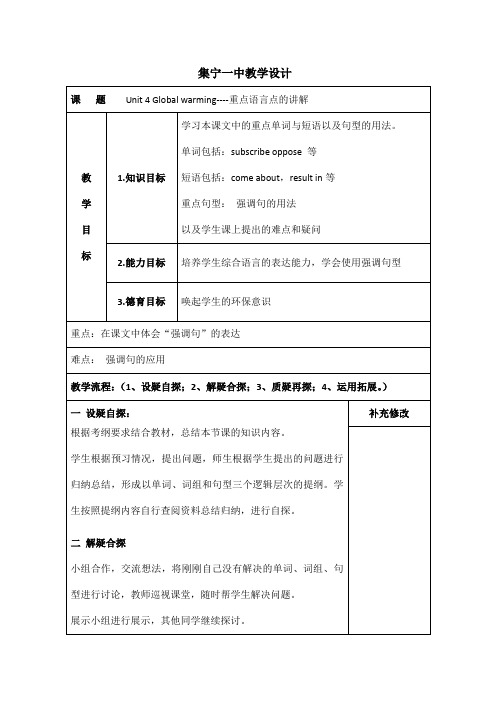
集宁一中教学设计精美句子1、善思则能“从无字句处读书”。
读沙漠,读出了它坦荡豪放的胸怀;读太阳,读出了它普照万物的无私;读春雨,读出了它润物无声的柔情。
读大海,读出了它气势磅礴的豪情。
读石灰,读出了它粉身碎骨不变色的清白。
2、幸福幸福是“临行密密缝,意恐迟迟归”的牵挂;幸福是“春种一粒粟,秋收千颗子”的收获. 幸福是“采菊东篱下,悠然见南山”的闲适;幸福是“奇闻共欣赏,疑义相与析”的愉悦。
幸福是“随风潜入夜,润物细无声”的奉献;幸福是“夜来风雨声,花落知多少”的恬淡。
幸福是“零落成泥碾作尘,只有香如故”的圣洁。
幸福是“壮志饥餐胡虏肉,笑谈渴饮匈奴血”的豪壮。
幸福是“先天下之忧而忧,后天下之乐而乐”的胸怀。
幸福是“人生自古谁无死,留取丹心照汗青”的气节。
3、大自然的语言丰富多彩:从秋叶的飘零中,我们读出了季节的变换;从归雁的行列中,我读出了集体的力量;从冰雪的消融中,我们读出了春天的脚步;从穿石的滴水中,我们读出了坚持的可贵;从蜂蜜的浓香中,我们读出了勤劳的甜美。
4、成功与失败种子,如果害怕埋没,那它永远不能发芽。
鲜花,如果害怕凋谢,那它永远不能开放。
矿石,如果害怕焚烧(熔炉),那它永远不能成钢(炼成金子)。
蜡烛,如果害怕熄灭(燃烧),那它永远不能发光。
航船,如果害怕风浪,那它永远不能到达彼岸。
5、墙角的花,当你孤芳自赏时,天地便小了。
井底的蛙,当你自我欢唱时,视野便窄了。
笼中的鸟,当你安于供养时,自由便没了。
山中的石!当你背靠群峰时,意志就坚了。
水中的萍!当你随波逐流后,根基就没了。
空中的鸟!当你展翅蓝天中,宇宙就大了。
空中的雁!当你离开队伍时,危险就大了。
地下的煤!你燃烧自己后,贡献就大了6、朋友是什么?朋友是快乐日子里的一把吉它,尽情地为你弹奏生活的愉悦;朋友是忧伤日子里的一股春风,轻轻地为你拂去心中的愁云。
朋友是成功道路上的一位良师,热情的将你引向阳光的地带;朋友是失败苦闷中的一盏明灯,默默地为你驱赶心灵的阴霾。
选修六Unit4Globalwarming教学设计
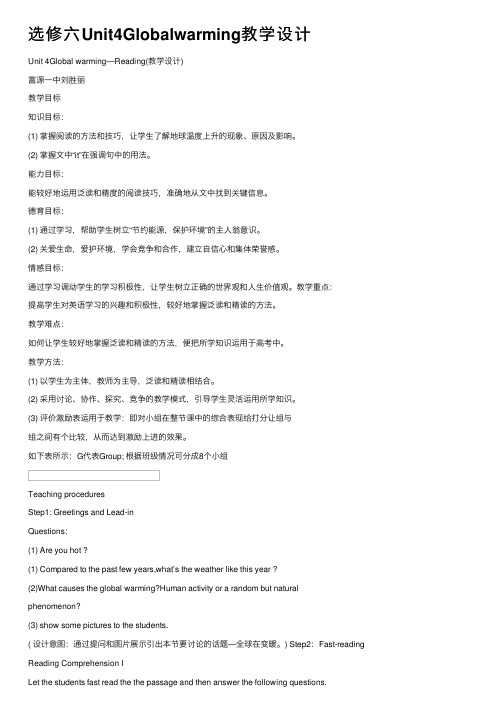
选修六Unit4Globalwarming教学设计Unit 4Global warming—Reading(教学设计)富源⼀中刘胜丽教学⽬标知识⽬标:(1) 掌握阅读的⽅法和技巧,让学⽣了解地球温度上升的现象、原因及影响。
(2) 掌握⽂中“it”在强调句中的⽤法。
能⼒⽬标:能较好地运⽤泛读和精度的阅读技巧,准确地从⽂中找到关键信息。
德育⽬标:(1) 通过学习,帮助学⽣树⽴“节约能源,保护环境”的主⼈翁意识。
(2) 关爱⽣命,爱护环境,学会竞争和合作,建⽴⾃信⼼和集体荣誉感。
情感⽬标:通过学习调动学⽣的学习积极性,让学⽣树⽴正确的世界观和⼈⽣价值观。
教学重点:提⾼学⽣对英语学习的兴趣和积极性,较好地掌握泛读和精读的⽅法。
教学难点:如何让学⽣较好地掌握泛读和精读的⽅法,便把所学知识运⽤于⾼考中。
教学⽅法:(1) 以学⽣为主体,教师为主导,泛读和精读相结合。
(2) 采⽤讨论、协作、探究、竞争的教学模式,引导学⽣灵活运⽤所学知识。
(3) 评价激励表运⽤于教学:即对⼩组在整节课中的综合表现给打分让组与组之间有个⽐较,从⽽达到激励上进的效果。
如下表所⽰:G代表Group; 根据班级情况可分成8个⼩组Teaching proceduresStep1: Greetings and Lead-inQuestions:(1) Are you hot ?(1) Compared to the past few years,what’s the weather like this year ?(2)What causes the global warming?Human activity or a random but natural phenomenon?(3) show some pictures to the students.( 设计意图:通过提问和图⽚展⽰引出本节要讨论的话题—全球在变暖。
) Step2:Fast-reading Reading Comprehension ILet the students fast read the the passage and then answer the following questions.1. What’s the main topic of the article?2. Who wrote the magazine article? What is name of the magazine?3. What has caused global warming?4.What do scientists think makes the earth’s temperature go up?5. How does “greenhouse effect” come about?Answers:1.It’s about global warming\the warming of the earth.2.They are Dr.Janice Foster,Charles Keeling and George Hambley.3.Human activity.4.The burning of fossil fuels.5. It comes about when small amounts of gases in the atmosphere trap heat from the sun and therefore warm the earth.(设计意图:训练学⽣归纳、总结的能⼒)Reading Comprehension II( pair work)Read the article again.Are these statements true or false( P27)? True(T) or False(F) questions. ( )1.The temperature in the last cen tury didn’t seem to increase much.( )2. Everyone believes that global warming is caused by the activities of humans.( )3. Janice Foster believes she can measure the future global rise intemperature.( )4. The rise in carbon dioxide is causing a steady increase in global warming. ( )5. George Hambley believes that global warming will do good rather than harm to the earth.( ) 6. It is clear what the effects of global warming will be.Answers: 1.T 2.T 3.F 4.T 5.T 6.F(设计意图:训练学⽣积极参与、协作、竞争的能⼒)Reading Comprehension IIIGet the students read the passage again and ask some students answer the following questions.1.The purpose of the first paragraph is to ___.A.introduce the writerB. explain a changeC. introduce the topicD. raise a question2. The graphs are used to _____.A.illustrate points by providing evidenceB.tell the change of temperatureC.tell the content of carbon dioxide in the airD.interest the readers3. Greenhouse gases refer to_______.A. carbon dioxideB. the burning of fossil fuelsC. byproducts of the burning of fossil fuelsD. coal, natural gas and oil4. Greenhouse effect _____.A. is a natural phenomenonB. happens when there’s too much carbon dioxideC. does great harm to human beingsD. makes life for human beings better5. _____ found out the amount of carbon dioxide in the atmospherefrom 1957 to1997.A. Dr. Janice FosterB. Charles KeelingC. George HambleyD. Sophie Armstrong6. Which of the following statements is True?A.Burning fossil fuels causes the global warming.B. We will have more food with global warming.C. Global warming means disasters to humans.D. More greenhouse gases will gather in the atmosphere.Answers: 1—5 CACAB 6.D设计意图:进⼀步训练和提升学⽣快速阅读,捕捉⽂中信息的能⼒。
高中英语选修六人教版:Unit+4+Global+Warming+教学设计1.doc

教学设计高二年级英语导学案品味人生1、不管鸟的翅膀多么完美,如果不凭借空气,鸟就永远飞不到高空。
想象力是翅膀,客观实际是空气,只有两方面紧密结合,才能取得显着成绩。
2、想停下来深情地沉湎一番,怎奈行驶的船却没有铁锚;想回过头去重温旧梦,怎奈身后早已没有了归途。
因为时间的钟摆一刻也不曾停顿过,所以生命便赋予我们将在汹涌的大潮之中不停地颠簸。
3、真正痛苦的人,却在笑脸的背后,流着别人无法知道的眼泪,生活中我们笑得比谁都开心,可是当所有的人潮散去的时候,我们比谁都落寂。
4、温暖是飘飘洒洒的春雨;温暖是写在脸上的笑影;温暖是义无反顾的响应;温暖是一丝不苟的配合。
5、幸福,是一种人生的感悟,一种个人的体验。
也许,幸福是你风尘仆仆走进家门时亲切的笑脸;也许,幸福是你卧病床上百无聊赖时温馨的问候;也许,幸福是你屡遭挫折心灰意冷时劝慰的话语;也许,幸福是你历经艰辛获得成功时赞赏的掌声。
关键的是,你要有一副热爱生活的心肠,要有一个积极奋进的目标,要有一种矢志不渝的追求。
这样,你才能感受到幸福。
6、母爱是迷惘时苦口婆心的规劝;母爱是远行时一声殷切的叮咛;母爱是孤苦无助时慈祥的微笑。
7、淡淡素笺,浓浓墨韵,典雅的文字,浸染尘世情怀;悠悠岁月,袅袅茶香,别致的杯盏,盛满诗样芳华;云淡风轻,捧茗品文,灵动的音符,吟唱温馨暖语;春花秋月,红尘阡陌,放飞的思绪,漫过四季如歌。
读一段美文,品一盏香茗,听一曲琴音,拾一抹心情。
8、尘缘飞花,人去楼空,梦里花落为谁痛?顾眸流盼,几许痴缠。
把自己揉入了轮回里,忆起,在曾相逢的梦里;别离,在泪眼迷朦的花落间;心碎,在指尖的苍白中;淡落,在亘古的残梦中。
在夜莺凄凉的叹息里,让片片细腻的柔情,哽咽失语在暗夜的诗句里。
9、用不朽的“人”字支撑起来的美好风景,既有“虽体解吾犹未变兮”的执着吟哦,也有“我辈岂是蓬蒿人”的跌宕胸怀;既有“我以我血荐轩辕”的崇高追求,也有“敢教日月换新天”的豪放气魄。
高中英语选修六人教版:Unit+4+Global+Warming+教学设计+(2).doc

人教版,选修6 Unit 4 Global Warming(Reading)教学设计THE EARTH IS BECOMING WARMER—DOES IT MATTER教学分析教学设计说明1、学习者分析学习动向:有强烈的求知欲和学习动机。
对全球变暖现象有着强烈的好奇和了解欲望。
语言水平:对知识的记忆和理解不存在问题,有较好地运用英语进行分析问题的能力,对自己的学习行为能作出较客观地评价。
学习风格:性格差异,学习风格各不相同,但都有自主、合作、探究的学习意识和能力,对学习行为具备一定的自我监控能力。
2、策略设计(1)有效的利用多媒体课件辅助课堂教学活动,丰富教学内容,提高学生学习兴趣和课堂教学效率,充分体现现代化教学技术的优点。
(2)通过教师与同学等人力资源及图书馆、网络等非人力资源查找有关全球变暖的资料,从而开拓视野,形成开放的文化态度。
3、教学方法设计:主要采用任务型教学法、学生中心教学法和多媒体教学法。
学生强烈的好奇心,在可操作的真实有效任务的驱动下,让学生在任务完成过程中充分认识到人类在生存过程中如何科学地改造自然来减少对全球变暖的影响及体验合作学习的成就感。
4、教学设备:多媒体设备课堂教学过程精美句子1、善思则能“从无字句处读书”。
读沙漠,读出了它坦荡豪放的胸怀;读太阳,读出了它普照万物的无私;读春雨,读出了它润物无声的柔情。
读大海,读出了它气势磅礴的豪情。
读石灰,读出了它粉身碎骨不变色的清白。
2、幸福幸福是“临行密密缝,意恐迟迟归”的牵挂;幸福是“春种一粒粟,秋收千颗子”的收获. 幸福是“采菊东篱下,悠然见南山”的闲适;幸福是“奇闻共欣赏,疑义相与析”的愉悦。
幸福是“随风潜入夜,润物细无声”的奉献;幸福是“夜来风雨声,花落知多少”的恬淡。
幸福是“零落成泥碾作尘,只有香如故”的圣洁。
幸福是“壮志饥餐胡虏肉,笑谈渴饮匈奴血”的豪壮。
幸福是“先天下之忧而忧,后天下之乐而乐”的胸怀。
幸福是“人生自古谁无死,留取丹心照汗青”的气节。
人教版选修六Unit 4 Global warming教案
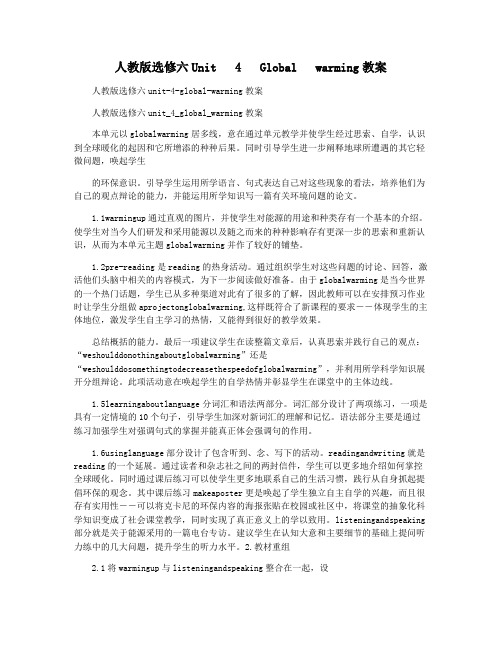
人教版选修六Unit 4 Global warming教案人教版选修六unit-4-global-warming教案人教版选修六unit_4_global_warming教案本单元以globalwarming居多线,意在通过单元教学并使学生经过思索、自学,认识到全球暖化的起因和它所增添的种种后果。
同时引导学生进一步阐释地球所遭遇的其它轻微问题,唤起学生的环保意识。
引导学生运用所学语言、句式表达自己对这些现象的看法,培养他们为自己的观点辩论的能力,并能运用所学知识写一篇有关环境问题的论文。
1.1warmingup通过直观的图片,并使学生对能源的用途和种类存有一个基本的介绍。
使学生对当今人们研发和采用能源以及随之而来的种种影响存有更深一步的思索和重新认识,从而为本单元主题globalwarming并作了较好的铺垫。
1.2pre-reading是reading的热身活动。
通过组织学生对这些问题的讨论、回答,激活他们头脑中相关的内容模式,为下一步阅读做好准备。
由于globalwarming是当今世界的一个热门话题,学生已从多种渠道对此有了很多的了解,因此教师可以在安排预习作业时让学生分组做aprojectonglobalwarming,这样既符合了新课程的要求――体现学生的主体地位,激发学生自主学习的热情,又能得到很好的教学效果。
总结概括的能力。
最后一项建议学生在读整篇文章后,认真思索并践行自己的观点:“weshoulddonothingaboutglobalwarming”还是“weshoulddosomethingtodecreasethespeedofglobalwarming”,并利用所学科学知识展开分组辩论。
此项活动意在唤起学生的自学热情并彰显学生在课堂中的主体边线。
1.5learningaboutlanguage分词汇和语法两部分。
词汇部分设计了两项练习,一项是具有一定情境的10个句子,引导学生加深对新词汇的理解和记忆。
人教版选修六Unit4《Globalwarming》word教案3
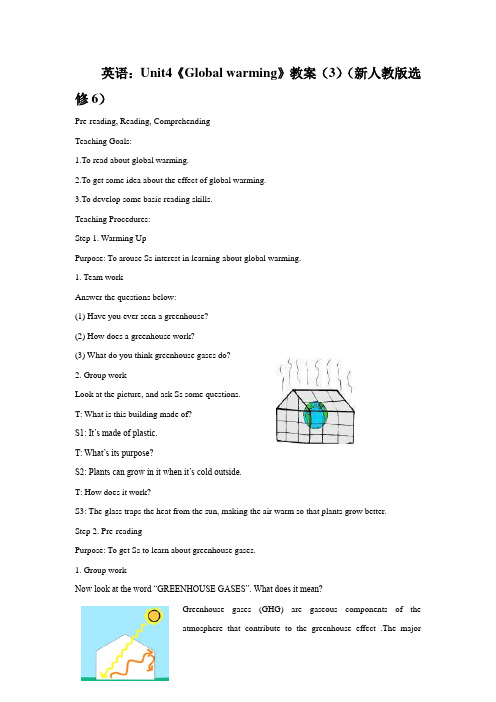
英语:Unit4《Global warming 》教案(3)(新人教版选修6)Pre-reading, Reading, ComprehendingTeaching Goals:1.To read about global warming.2.To get some idea about the effect of global warming.3.To develop some basic reading skills.Teaching Procedures:Step 1. Warming UpPurpose: To arouse Ss interest in learning about global warming.1. Team workAnswer the questions below:(1) Have you ever seen a greenhouse?(2) How does a greenhouse work?(3) What do you think greenhouse gases do?2. Group workLook at the picture, and ask Ss some questions.T: What is this building made of?S1: It’s made of plastic.T: What’s its purpose?S2: Plants can grow in it when it’s cold outside.T: How does it work?S3: The glass traps the heat from the sun, making the air warm so that plants grow better. Step 2. Pre-readingPurpose: To get Ss to learn about greenhouse gases.1. Group workNow look at the word “GREENHOUSE GASES”. What does it mean?Greenhouse gases (GHG) are gaseous components of theatmosphere that contribute to the greenhouse effect .Themajornatural greenhouse gases are water vapor, which causes about 36-70% of the greenhouse effect on Earth (not including clouds): carbon dioxide, which causes between 9-26%; and ozone, which causes between 3-7%(note that it is not really possible to assert that such-and-such a gas causes a certain percentage of the GHE, because the influences of the various gases are not additive .The higher ends of the ranges quoted are for the gas alone ;the lower end ,for the gas counting overlaps).Naturally occurring greenhouse gases include water vapor, carbon dioxide, methane, nitrous oxide, and ozone. Certain human activities, however, add to the levels of most of these naturally occurring gases.Very powerful greenhouse gases that are not naturally occurring include hydrofluorocarbons (HFCs), perfluorocarbons (PFCs), and sulfur hexafluoride (SF6), which are generated in a variety of industrial processes.Each greenhouse gas differs in its ability to absorb heat in the atmosphere. HFCs and PFCsare the most heat-absorbent.2. Individual workGet Ss to answer these questions individually. Then let them discuss the answers.(1) Who wrote the magazine article? What is the name of the magazine?(2) What are the names of the three scientists mentioned in the article?(3) What do they think about global warming? Do they agree with one another?(4) What are the two graphs about?(5) What is the main topic of the article?Step 3. Reading1. SkimmingPurpose: To get a brief understanding of the text.Read through the text, preferably the first and the last sentences of each paragraph and write the key sentence of each paragraph.Key sentences of each paragraph:(1) A debate over whether it is human activity that has caused the global warming or whether it is just a natural phenomenon.(2) Many scientists believe people have caused the increase in the earth’s temperature.(3) The increased extra amount of carbon dioxide traps more heat energy causing the global temperature to go up.(4) The levels of carbon dioxide have increased greatly over the last 100 to 150 years.(5) There are some different attitudes towards the causes of this increase in carbon dioxide.(6) Over the next 100 years the amount of warming could be as low as 1 to 1.5 degrees Celsius but it could be as much as 5 degrees Celsius.(7) An increase of five degrees would be a catastrophe.(8) Future warming would cause the sea level to rise by several meters.(9) Some predict any warming will be mild with few bad environmental consequences.(10) More carbon dioxide is a positive thing.(11) No one knows what the effects of global warming will be.2. ScanningPurpose: To get Ss to have some details in the text.Read the article carefully. Are these statements true or false? Write a T for each true sentence and an F for each false sentence.(1) The temperature last century didn’t increase much. ( )(2) Everyone believes that global warming is caused by the activities of humans. ( )(3) Janice Foster believes that burning fossil fuels causes global warming. ( )(4) Natural gas is a greenhouse gas. ( )(5) Carbon dioxide is a byproduct of burning fossil fuels. ( )(6) People accept Charles Keeling ’s data because he took accurate measurement s. ( )(7) Flooding could be one of the effects of future global warming. ( )(8) George Hambley believes scientists are just guessing about the effects of global warming.( )(9) Geroge Hambley is worried about the effects of carbon dioxide on plant growth. ( )(10) It is clear what the effects of global warming will be.Suggested Answers:(1) F (2) F (3) T (4) F (5) T (6) T (7) T (8) T (9) F (10) F3. ListeningPurpose: To train Ss listening ability.Listen to the tape and follow it in a low voice.。
- 1、下载文档前请自行甄别文档内容的完整性,平台不提供额外的编辑、内容补充、找答案等附加服务。
- 2、"仅部分预览"的文档,不可在线预览部分如存在完整性等问题,可反馈申请退款(可完整预览的文档不适用该条件!)。
- 3、如文档侵犯您的权益,请联系客服反馈,我们会尽快为您处理(人工客服工作时间:9:00-18:30)。
一课时
教材
分析
This is the third teaching period of the unit .In this period ,the teaching emphasis will be put on the uses of it
学情
分析
Students may know something about it ,but they still need to summarize the uses of it
课程
类型
Important language points
课时
一课时
教材
分析
This is the second teaching period of the unit .In this period we will deal with someimportantlanguage points in the passage .make sure students can grasp some useful words ,phrases and sentences patterns .
2. Develop students’sense of group cooperation
教学
方法
1.Task–based teaching and learning
2.cooperative learning and practice
教学
手段
Ablackboard
2. Enablestudentsto make sentences after the useful sentence patterns
(三)情感目标
1.Stimulatestudents’interest in learning English.
2. Develop students’spirit of cooperation and teanwork
教学
方法
1.task-based teaching and learning
2.cooperative learning
教学
手段
Some slides and a blackboard .
教学过程设计
教学步骤
教师活动
学生活动
Step 1Revision
Check the homework exercises
do some practice
Step 5Homework
Finish off the exercises in workbook.
Reflection After Teaching(教学反思)
教学
课题
Period 3 learning about Grammar
课程
类型
Grammar learning
Can understand the main idea of the whole passage
(四)情感态度目标
To know the importance of protecting the environment.
教学
方法
Task-based approach and communicative approach
教学
重难点
To learn the uses of it
教学
目标
(一)知识目标
To learn the uses of it
(二)能力目标
Enable students to to learnitcorrectly
(三)情感目标
1.Get students to become interested in grammar learning .
2.How to improve the students’reading ability .
教学
目标
一、知识目标
To master the expressionabout global warming, and learn to analyze the difficult sentences.
二、技能目标
4.The rise in carbon dioxide is causing a steady increase in global warming.
5.George Hambley believes that global warming will do good rather than harm to the earth.
学情
分析
The students areinterestedin thetopic.After a year’s English learning ,most of them have formed some basic reading skills ,which contribute to the development of the class.
学情
分析
Students are poor at English .many of them can not use certain words ,phrases and sentences patterns correctly . They need a lot of practice to improvetheirEnglish .
教学
目标
(一)知识目标
To grasp someuseful words and expressions andlearn some useful sentence patterns
(二)能力目标
1.Get students to use someuseful words and expressions correctly .
Look at the picture and try to discuss the uses of a greenhouse
Step4Fast reading
Ask students’to skim the text and match the main idea with each paragraph.
Discuss the question in groups and try to write down
Step 7Homework
Do Ex 1 in workbook
Reflection After Teaching(教学反思)
教学
课题
Petiod 2Important language points
Step5
Carefulreading
Ask students to read the text carefully anddecide the following statements True or False.
1.The temperature in the last century did not seem to increase much.
Answer the questions aloud
Get the Ss to look at the pictures and the title of the reading passage and predict the content and then lead into the new lesson.
教学
重点
1.Master the useful words and expressions.
2. learn some useful sentence patterns
教学
难点
1. grasp someuseful words and expressions.
2. learn some useful sentence patterns
教学
重点
1.Improve the students’reading ability.
2.Master the useful words and expressions.
教学
难点
1.How to help the students master the usage of the useful words and phrases in the passage .
6.It is clear what the effects of global warming will be.
Read the passage carefully and try to find some detailed information
Step 6Discussion
Ask students to discuss :Should we do nothing about global warming?
Para5 Epuzzles about global warming
Para6 Fdifferent attitudes to global warming
Para7 G
Read the passage quickly and try to findthe main idea with each paragraph.
教学
课题
Unit 4 Global warming period1
课程
类型
Warming up and reading
课时
一课时
教材
分析
本节课的内容是人民教育出版社出版的NSE高中教材必修6第四单元的Pre-reading, Reading, Comprehension部分,本单元的话题是全球变暖。本节课是单元的阅读课,教材以说明文的文体呈现,教师可在充分利用教材资源的基础上,结合学生的实际情况设计教学活动,旨在帮助学生有效地掌握阅读技巧,形成有效地学习方法和阅读策略,同时了解说明文篇章结构和写作特点,为下一步进行说明文的写作教学做好准备。
